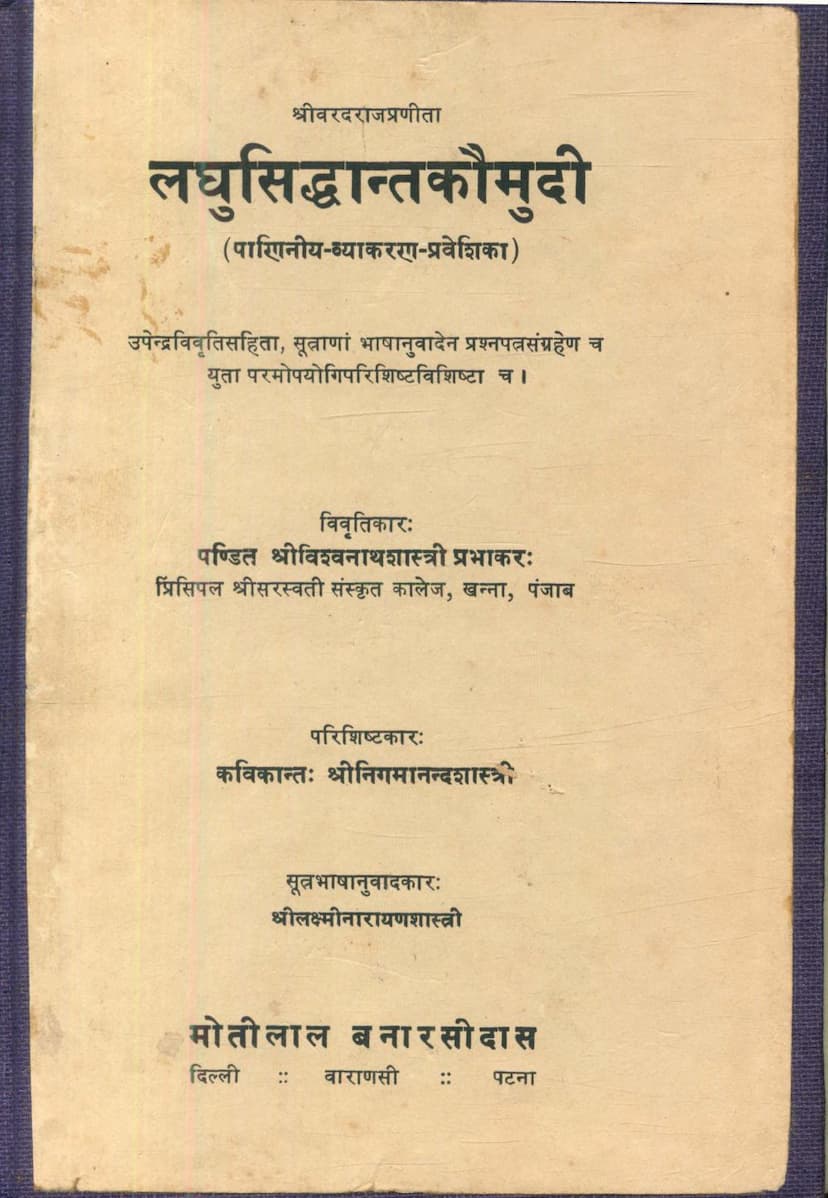Laghu Siddhant Kaumudi Part 01
Added to library: September 2, 2025

Summary
Here's a comprehensive summary of the provided Jain text, "Laghu Siddhant Kaumudi Part 01," based on the content you've shared:
Title: Laghu Siddhant Kaumudi Part 01 (A Primer to Paninian Grammar)
Author(s): Vishvanath Shastri, Nigamanand Shastri, Lakshminarayan Shastri
Publisher: Motilal Banarsidass Pvt Ltd
Core Subject: This book is an introductory guide to Panini's grammar, a foundational text for the Sanskrit language. It aims to provide a systematic and accessible entry point into this complex field of linguistic science.
Key Features and Content:
-
Introduction to Sanskrit's Importance: The preface (Bhoomika) emphasizes Sanskrit's esteemed position among ancient languages, its connection to Indian culture and heritage, and its status as the mother of many Indian languages. It highlights the richness of Sanskrit literature and the scientific approach of Western scholars in studying it.
-
The Significance of Grammar (Vyakaran): The text stresses the essential role of grammar in preserving a language's purity and fundamental knowledge. It traces the origin of grammar to ancient Vedic times, acknowledging the contributions of various grammarians before Panini, and ultimately presenting Panini's Ashtadhyayi as the culminating and most scientific work in the field.
-
Panini and His Work (Ashtadhyayi):
- Introduction of Panini: The book details Panini's biographical information, including his various names (like Dakshiputra, Shaliki), his lineage (mother Dakshi, father Shala?), and his birthplace (Shalatur, currently in Pakistan). It discusses the likely educational path, possibly at Takshashila University.
- Structure of Ashtadhyayi: It describes the Ashtadhyayi's structure: eight chapters (Adhyayas), each divided into four sections (Padas), containing approximately 3655 sutras in total.
- The Trimuni of Grammar: It introduces the three pillars of Paninian grammar: Panini (the sutra composer), Katyayana (the Vartikakara), and Patanjali (the Bhashyakara).
-
Katyayana and Patanjali: Briefly introduces Katyayana (also known as Vararuchi), the author of Vartikas, and Patanjali, the author of the Mahabhashya, both crucial commentaries on Panini's sutras.
-
Evolution of Grammatical Study: The text traces the historical progression of studying Panini's grammar, from the initial memorization of the Ashtadhyayi to the development of commentary traditions (like Jayaditya and Vamana's Kashikavritti) and the emergence of process-oriented grammar (Prakriya).
-
Bhattoji Dikshita and Siddhanta Kaumudi: Highlights Bhattoji Dikshita's significant contribution in compiling the Siddhanta Kaumudi, a comprehensive and process-oriented exposition of Panini's grammar that became widely popular. It also mentions prominent commentaries on the Siddhanta Kaumudi.
-
Varadaraja and Laghu Siddhanta Kaumudi: Introduces Varadaraja, Bhattoji Dikshita's disciple, as the author of Laghu Siddhanta Kaumudi. This work is presented as a simplified and abridged version of Siddhanta Kaumudi, designed specifically for beginners and young students. The text also mentions Varadaraja's Madhya Siddhanta Kaumudi as a subsequent step for students.
-
Structure and Approach of Laghu Siddhanta Kaumudi:
- Content Organization: The book outlines the chapter sequence of Laghu Kaumudi, noting its logical arrangement (Sandhi, Linga, Avyaya, Tinanta, Kritya, Krudanta, Samasa, Tadita, Stripratyaya), which differs from the Ashtadhyayi's structure for pedagogical ease.
- Commentary (Upendra Vivriti): The specific edition being summarized includes an explanation titled "Upendra Vivriti" by Vishvanath Shastri, which aims to clarify the sutras with Hindi translations and explanations, making it highly useful for students.
- Appendices: The book includes valuable appendices for learners, such as Madhvimanushasana (likely a simplified rule set), explanations of grammatical concepts, a discussion on the chronology of Panini and other grammarians, notes on common errors in translation, prefixes with meanings, a root list (Dhatupatha) with meanings, and collected verb forms (Prayogasangraha). It also provides sample exam papers and questions.
-
Detailed Grammatical Sections: The provided text includes detailed explanations of several core grammatical topics, including:
- Sangya Prakarana (Nomenclature): Covers the introduction of various phonetic and grammatical terms and their definitions (like It, Lopa, Pratyahara, Savarna).
- Sandhi Prakarana (Euphony): Explains rules of vowel sandhi (Ach Sandhi) and consonant sandhi (Hal Sandhi), along with visarga sandhi.
- Taddhita Prakarana (Derivative Suffixes): Covers suffixes added to nouns and other bases to form new words, categorized by their meanings (like Apitya, Raktaadi, Chanturarthika, Shleshika, Taddhita rules).
- Tinanta Prakarana (Verbs): Explains the conjugation of verbs, including the various tenses (Lata, Lit, Lut, etc.), moods (Parasmaipada, Atmanepada), and the formation of verb roots (Dhatu).
- Krit Prakarana (Primary Suffixes): Deals with suffixes added to verb roots to form nouns and adjectives.
- Samasa Prakarana (Compounding): Explains the rules of compounding words, covering categories like Avyayibhava, Tatpurusha, Bahuvrihi, and Dvanda.
- Stripratyaya Prakarana (Feminine Suffixes): Details the suffixes used to form feminine nouns.
- Nirukta and Phonetics: Touches upon phonetic concepts like sthana (place of articulation), prayatna (effort of articulation), and various types of sandhi.
-
Commentary Details: The text mentions "Upendra Vivriti" by Vishvanath Shastri as the specific commentary included, emphasizing its student-centric approach with Hindi translations and explanations.
-
Biographical Information of Commentators: Pages 15-21 provide detailed genealogical and biographical information about the lineage of the commentators, particularly focusing on Pandit Keshavram Sharma Prabhakar and his family's contribution to grammatical scholarship.
Overall Purpose:
The "Laghu Siddhanta Kaumudi Part 01" serves as a comprehensive introduction to Paninian grammar, designed to make the study of Sanskrit accessible and systematic for students. It builds upon the legacy of great grammarians and provides a structured learning path, complemented by detailed explanations and practical examples. The inclusion of various appendices further enhances its value as a study aid for examinations.